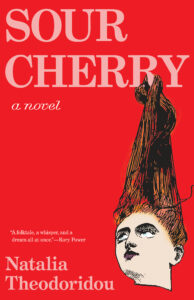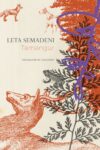
[Tin House; 2025]
Sour Cherry, published this past spring, is Natalia Theodoridou’s dark fable about domestic abuse and masculinity. Theodoridou works largely from the folktale, Bluebeard, in which a doomed heroine marries a lord with a secret locked room in his castle for hiding the bodies of his many previous murdered wives. Theodoridou joins the many writers who have looked to that particular story shape — Angela Carter, Carmen Maria Machado, and Margaret Atwood, among others — to discuss violent men, victimized women, and the stories we keep hidden from each other.
Theodoridou opens his version with an announcement that what is to follow is a fairy tale, though the unnamed narrator lives in the twenty-first century. She is in an apartment, in sweatpants and a torn shirt. She is telling the tale to her child, aided by a chorus of ghost women who, the narrator reports, speak to her constantly, critiquing her storytelling choices.
The narrator’s tale begins with the story of Agnes, who, as a young woman, becomes a wet nurse to the son of a lord. We follow Agnes for many years, as the baby grows into a strange child, and then a teenager whose mere presence sickens the earth and the beings around him:
The cattle stopped giving milk; ewes stopped birthing. Everywhere in the village, the fruit darkened and fell off the trees […] the earth exhaled a cloud of dust. Even the stone wall that circumscribed the property crumbled.
Agnes’ own baby dies before she even meets the baby boy, possibly because she lives in the town he is blighting. A local child is mauled by dogs seemingly at the boy’s command. Agnes’ lover wastes away. When the boy is in his late teens, his father is fatally injured. Local women give birth to stones. While the boy is always involved, his hand is never quite seen to be choking the life from anyone, though his awareness of his effect on the world becomes ever more undeniable as he reaches maturity. Despite all of this, Agnes attempts to remain with the boy as a caretaker, and then as a cook.
From Agnes, the perspective of the tale passes to the boy’s first girlfriend Eunice, who later becomes his first wife. This new form of love does not bring a reprieve from the destruction. In fact, his literal toxicity seems increasingly potent as his conscience becomes less and less burdened. Soon, the narration is passed from doomed consort to doomed consort, while we occasionally slip back to the novel’s original vantage point, where a woman is telling her son the story in their apartment, keeping him from entering a bedroom while they wait for a friend to arrive. We don’t know at first why she won’t allow her son to enter the room, only that she is refusing to open the door for any reason: “Slippers, left by the bed, and I don’t dare fetch them from behind that door.” She speaks from a contemporary perch, but the logic behind her protection is folkloric.
There is a real tragedy at the heart of the novel, a tragedy taking place in a real city, to people of flesh and blood, and yet Theodoridou and his nameless narrator choose to spend most of the text formally borrowing the structures, language, and cadences of a fairy tale: “The tenth wife thought she was with child when she found something in the garden, something beautiful and terrible and pale, that looked like a shell but moved.” For the most part, reading Sour Cherry feels like reading a three-hundred-page folktale rather than a retelling in contemporary drag, with modern niceties like dialogue and psychologically rounded characters — elements that Theodoridou has intentionally excluded. The folklorist and scholar Maria Tatar wrote, in The Classic Fairy Tales, “Feminist writers have resisted the temptation to move in the imitative mode, choosing instead the route of critique and parody in their recastings of tales.” Theodoridou, however, is a feminist writer who does move in the imitative mode. The reason for this might lie in words from the fairy godmother of modern retellings, Angela Carter, whose story “The Bloody Chamber” (published in 1979) was a subversion of the Bluebeard tale:
Ours is a highly individualized culture, with a great faith in the work of art as a unique one-off, and the artist as an original, godlike and inspired creator of unique one-offs. But fairy tales are not like that, nor are their makers. Who first invented meatballs? In what country? Is there a definitive recipe for potato soup? Think in terms of the domestic arts. ‘This is how I make potato soup.’
A fairytale or folktale, in its original oral form, has the power to escape the limits of single-authorship and the isolation of individual experience. Theodoridou makes his tale in the traditional way, by packing his pot full of specific acts of violence, but simmering it all down until what’s left is an inescapable and widely experienced truth: that violent men cannot be saved from their violence by their victims, and that you cannot break a cycle of abuse merely by considering yourself an exception to its pattern. Theodoridou is uninterested in telling a tale of or by a heroic individual, but rather in bearing witness to this shared narrative.
From the beginning, we are aware that the story of Sour Cherry is a shared one — the narrator is assisted by her chorus of ghosts — but it is the penultimate section of the book that widens the frame. Here, Theodoridou, takes readers beyond named characters like Agnes and Eunice, and largely beyond hope. In these chapters, the story follows a line of numbered wives and lovers who all share the same fate: they will marry the man, they will sicken and die or find out the fates of the previous wives and escape, only to die anyway. Following this litany, the narrator enters the story, giving herself a fairy tale stand-in called only the “Cherry Girl.” At first, this Cherry Girl starts a life with the novel’s bad man believing she has overcome the cycle simply by being his lover instead of his wife, but the brutal pattern is fulfilled yet again.
This repetition, and the flatness of these characters, are central techniques of the book’s folktale effect. Fairy tale writer and scholar Kate Bernheimer wrote that a fairy tale’s flatness “allows depth of response in the reader,” while folklore theorist Max Lüthi claimed that the repetition in a classic tale mirrors our endlessly repeating world. Or, as Theodoridou’s villagers put it, endlessly watching the cycle of the man’s destruction of their land and daughters and sisters: “These things happen […] This is the way of the world.”
One obvious question at the center of all of this is whether there is a kind of perniciousness to a fairy tale, in its representation of an apparently inescapable status quo. Why insist on repetition instead of on the more contemporary literary pattern of rupture and evolution? Theodoridou does not resolve this question, but allows his characters to ask it many times, “She saw it for what it was: the bones of all her predecessors, his dead wives. When she found it on her own skin, sticking to the damp of her nightgown, she asked herself: What am I doing here? Why don’t I leave? […] And yet, here she is now, in the chorus.”
In her essay, “The Useful Dangers of Fairy Tales,” writer Amber Sparks talks about the “older feminism” entrenched in such stories, the kind that were meant to be passed from mother to daughter as warnings and guidance to be leaned on after she was gone. Sparks sees the necessity of this, but wrestles with the lack of empowerment and representation in these stories:
Someday, my daughter will ask me why there are no mothers in these fairy tales, and I will tell her that the world was a dangerous place for women back then.
Back then, I will say, and I will load that phrase with as much meaning as I can. I will not add, ‘and now.’
Theodoridou adds it. He is telling this story for the ghost wives in the chorus without providing them a way out. But he’s telling it for someone else, too. His narrator-mother is telling her tale to a son, not a daughter. The story is both an explanation of the narrator’s own doomed relationship with the real man who inspired the monstrous husband of her story, and a warning to his son.
Theodoridou writes in his ARC note that as he was writing, he was also transitioning, and thinking very explicitly about what kind of man to become. The novel’s treatment of masculinity is slippery, difficult to pin down. Its most central image is the husband’s monstrosity, which causes the living earth and people around him to rot. This is not a power he chooses: he is born to it, but he does also choose to spend his life using his power and covering it up. This literal male toxicity feels, at times, like an original-sin-type framing of violent masculinity that I personally find difficult to stomach in its essentialism.
This particular fairy tale has been devised to explain the existence of a particular violent man, and since his allegorical counterpoint begins to damage the world in childhood, we receive the story that the man was born “bad.” Even when the boy acts with intent, it is always with a child’s half-awareness about his own effect on things: “he’d run to the pond and throw stones at the ducks, laugh first and then frown, as if surprised by his own violence.” Was this violent taint really there from the beginning? And if so, can we really attach blame to the boy himself? Was the gradual worsening of this violence as inevitable as the story suggests? The narrator herself doubts this frame by the end: “Easier to tell you of a man who was a myth, a natural disaster, a fairy-tale thing, than to say your father is a wife-beater, a rapist, a murderer.” But still, it is this easier story she chooses to tell her child.
Theodoridou includes plenty of men and boys in his story who do not bear the same toxic powers or violent tendencies as the bad man, ones who ask whether they have the same monstrosity by virtue of having been born male, and who genuinely want to give their lives to be something different. But in a divergence from the traditional fairy tale arc, these would-be heroes do not save anyone, unless it is themselves. Even the possibility of self-preservation is doubtful. Theodoridou’s fairy tale version of masculinity is bleak and at times a little too familiar. It holds that men’s violence is essentially impossible to escape, both for its victims and those who move to put an end to it. It is a story we are endlessly told in true crime podcasts, SVU binges, and the news. Still, Theodoridou does not leave this black-and-white vision uninterrogated. Without giving concrete answers, he asks us to consider the use of the tales we tell each other, and who we are guarding when we adapt our hardest stories to go down easier.
Amelia Brown is a writer living in Boston. She holds an MFA from Bennington College.
This post may contain affiliate links.






